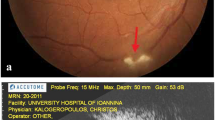Abstract
Purpose
To create a diagnostic algorithm for the management of chorioretinal folds.
Methods
We reviewed the existing literature about chorioretinal folds focusing our attention on three specific conditions and created a diagnostic algorithm in order to otpimize the choice and the number of investigations.
Results
Chorioretinal folds are visible striations of the fundus usually arranged in parallel lines and disposed horizontally. They may be either unilateral or bilateral, symptomatic or asymptomatic and are often associated with different possible ocular and extra ocular pathologies, including systemic diseases like autoimmune disorders and intracranial hypertension. They are named idiopathic when no apparent cause for their development is detectable. However, with improved diagnostic testing, the patients with idiopathic choroidal folds are likely to represent only a smaller portion of the total.
Conclusions
Since choroidal folds be the sole sign of an underlying disease possibly requiring a multidisciplinary approach, an appropriate work-up varying according to the specific clinical features of each case is needed to define the etiology and the treatment. A diagnosting algorithm may be useful in order to optimize the diagnostic approach and management.



Similar content being viewed by others
References
Agarwal A (2011) Gass’ atlas of macular diseases, 5th edn. Elsevier Health Sciences, Amsterdam
Leahey AB, Brucker AJ, Wyszynski RE, Shaman P (1993) Chorioretinal folds. A comparison of unilateral and bilateral cases. Arch Ophthalmol Chic Ill 111:357–359
Friberg TR (1989) The etiology of choroidal folds. A biomechanical explanation. Graefes Arch Clin Exp Ophthalmol 227:459–464
Nettleship E (1884) Peculiar lines in the choroid in a case papillitic atrophy. Ophthalmol Soc U K 4:167–168
Cangemi FE, Trempe CL, Walsh JB (1978) Choroidal folds. Am J Ophthalmol 86:380–387. https://doi.org/10.1016/0002-9394(78)90243-X
Cohen SM, Gass JDM (1994) Bilateral radial chorioretinal folds. Int Ophthalmol 18:243–245. https://doi.org/10.1007/BF00951806
Denniston A, Murray P (2009) Oxford handbook of ophthalmology, 2nd edn. Oxford University Press, Oxford, New York
Md PKK, Md NJF, Md RPII (2014) The Massachusetts eye and ear infirmary illustrated manual of ophthalmology, 4th edn. Saunders, Philadelphia
Griebel SR, Kosmorsky GS (2000) Choroidal folds associated with increased intracranial pressure. Am J Ophthalmol 129:513–516
Lavinsky J, Lavinsky D, Lavinsky F, Frutuoso A (2007) Acquired choroidal folds: a sign of idiopathic intracranial hypertension. Graefes Arch Clin Exp Ophthalmol Albrecht Von Graefes Arch Klin Exp Ophthalmol 245:883–888. https://doi.org/10.1007/s00417-006-0455-7
Kim KY, Kwak H-W, Kim M, Yu S-Y (2013) Traumatic chorioretinal folds treated with intra-vitreal triamcinolone injection. Indian J Ophthalmol 61:179–182. https://doi.org/10.4103/0301-4738.112165
Söylev MF, Saatci O, Saatci I et al (1996) Choroidal folds associated with a sellar mass. Int Ophthalmol 20:259–261. https://doi.org/10.1007/BF00131920
Ernst BB, Lowder CY, Meisler DM, Gutman FA (1991) Posterior segment manifestations of inflammatory bowel disease. Ophthalmology 98:1272–1280. https://doi.org/10.1016/S0161-6420(91)32143-2
Grinager HS, Krason DA, Olsen TW (2012) Lyme disease: resolution of a serous retinal detachment and chorioretinal folds after antibiotic therapy. Retin Cases Brief Rep 6:232–234. https://doi.org/10.1097/ICB.0b013e3182247783
Krist D, Wenkel H (2002) Posterior scleritis associated with Borrelia burgdorferi (Lyme disease) infection. Ophthalmology 109:143–145
Leventer DB, Linberg JV (1960) Ellis B (2001) Frontoethmoidal mucoceles causing bilateral chorioretinal folds. Arch Ophthalmol Chic Ill 119:922–923
Taban M, Kosmorsky GS, Singh AD, Sears JE (2007) Choroidal folds secondary to parasellar meningioma. Eye Lond Engl 21:147–150. https://doi.org/10.1038/sj.eye.6702479
Kalina RE, Mills RP (1980) Acquired hyperopia with choroidal folds. Ophthalmology 87:44–50
Gass’ Atlas of Macular Diseases, 5th edn. https://www.elsevier.com/books/gass-atlas-of-macular-diseases/agarwal/978-1-4377-1580-4. Accessed 14 Nov 2017
Murdoch D, Merriman M (2002) Acquired hyperopia with choroidal folds. Clin Experiment Ophthalmol 30:292–294
Olsen TW, Palejwala NV, Lee LB et al (2014) Chorioretinal folds: associated disorders and a related maculopathy. Am J Ophthalmol 157:1038–1047. https://doi.org/10.1016/j.ajo.2014.02.021
Fannin LA, Schiffman JC, Budenz DL (2003) Risk factors for hypotony maculopathy. Ophthalmology 110:1185–1191. https://doi.org/10.1016/S0161-6420(03)00227-6
Schubert HD (1996) Postsurgical hypotony: relationship to fistulization, inflammation, chorioretinal lesions, and the vitreous. Surv Ophthalmol 41:97–125
Thomas M, Vajaranant TS, Aref AA (2015) Hypotony maculopathy: clinical presentation and therapeutic methods. Ophthalmol Ther 4:79–88. https://doi.org/10.1007/s40123-015-0037-z
Rivara A, Zingirian M (1968) Volume du bulbe et rigidité sclérale. Ophthalmologica 156:394–398. https://doi.org/10.1159/000305482
Benson WE (1988) Posterior scleritis. Surv Ophthalmol 32:297–316
Cavallini GM, Volante V, Bigliardi MC et al (2014) Bilateral posterior scleritis as a presenting manifestation of giant cell arteritis: a case report. Can J Ophthalmol J Can Ophtalmol 49:e141–e143. https://doi.org/10.1016/j.jcjo.2014.08.015
McCluskey PJ, Watson PG, Lightman S et al (1999) Posterior scleritis: clinical features, systemic associations, and outcome in a large series of patients. Ophthalmology 106:2380–2386. https://doi.org/10.1016/S0161-6420(99)90543-2
Onal S, Tugal-Tutkun I, Neri P, Herbort CP (2014) Optical coherence tomography imaging in uveitis. Int Ophthalmol 34:401–435. https://doi.org/10.1007/s10792-013-9822-7
Haruyama M (2001) Indocyanine green angiographic findings of chorioretinal folds. Jpn J Ophthalmol 45:293–300. https://doi.org/10.1016/S0021-5155(01)00323-9
Del Turco C, Rabiolo A, Carnevali A et al (2017) Optical coherence tomography angiography features of chorioretinal folds: a case series. Eur J Ophthalmol 27:35–38. https://doi.org/10.5301/ejo.5000872
Musetti D, Nicolò M, Bagnis A, Traverso CE (2014) Chorioretinal folds: associated disorders and a related maculopathy. Am J Ophthalmol 158:409. https://doi.org/10.1016/j.ajo.2014.05.005
Author information
Authors and Affiliations
Corresponding author
Ethics declarations
Conflict of interest
All authors declare that they have no conflict of interest.
Ethical approval
All procedures performed in studies involving human participants were in accordance with the ethical standards of the institutional and/or national research committee and with the 1964 Helsinki declaration and its later amendments or comparable ethical standards.
Informed consent
Informed consent was obtained from all individual participants included in the study.
Additional information
Publisher's Note
Springer Nature remains neutral with regard to jurisdictional claims in published maps and institutional affiliations.
Rights and permissions
About this article
Cite this article
Bagnis, A., Cutolo, C.A., Corallo, G. et al. Chorioretinal folds: a proposed diagnostic algorithm. Int Ophthalmol 39, 2667–2673 (2019). https://doi.org/10.1007/s10792-019-01083-y
Received:
Accepted:
Published:
Issue Date:
DOI: https://doi.org/10.1007/s10792-019-01083-y




